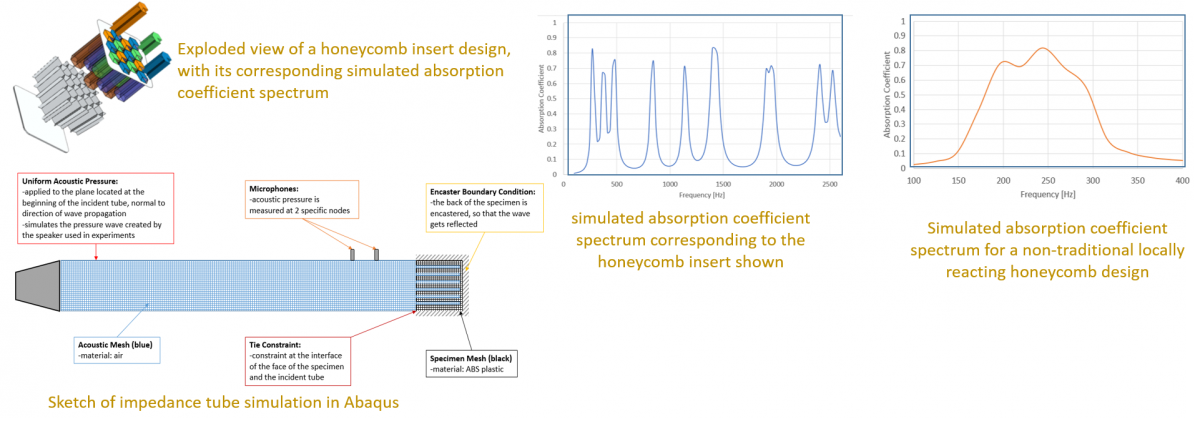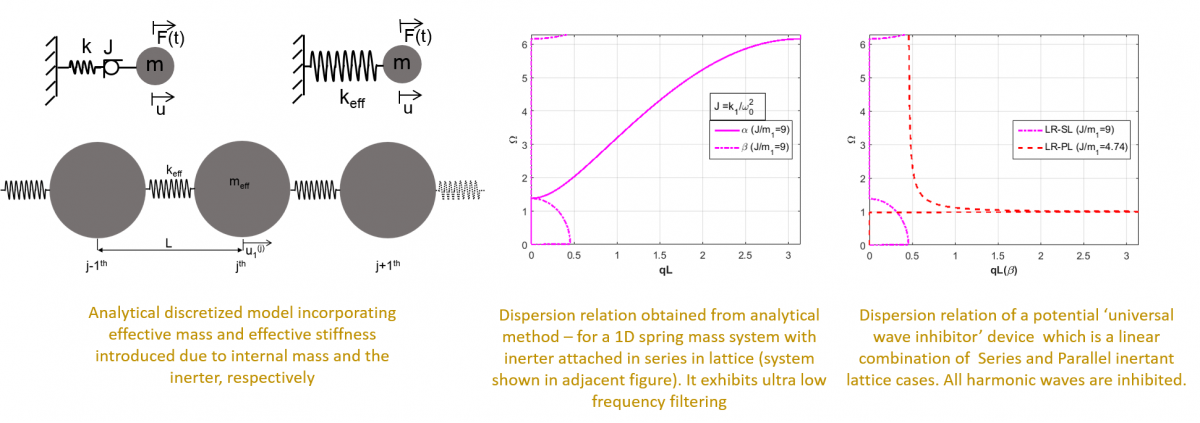Current Research
1. Lightweight, compact acoustic liner composites for improved low-frequency performance
Low-frequency (<~400 Hz) airborne noise has several detrimental effects ranging from excitation of structural vibration modes with potentially catastrophic results, reduction of passenger comfort and payload integrity in commercial vehicles, restriction of military mission capabilities due to enhanced acoustic signature and contribution to environmental noise pollution. Conventional acoustic liners incorporating resonating chambers and foam or fiberglass claddings and cores are used to mitigate airborne noise. However, these are found to be ineffective or impractical for acoustic sources with dominant frequencies below about 400 Hz. Therefore, there is a need to develop alternative lightweight, compact techniques to improve low-frequency sound absorption within and transmission loss through structures for aerospace, military and civil infrastructural applications. An approach combining innovative internal geometries with high specific-strength Amorphous Metal Honeycombs (AMH) and novel manufacturing processes is proposed to create lightweight, compact structurally-integrated acoustic liners with enhanced damage tolerance as well as unprecedented low-frequency acoustic performance. Design studies are conducted on three candidate low-frequency liner concepts – (a) Core-integrated resonators, (b) Stacked-L core and (c) Phased slanted-U core – to optimize and down-select the best configurations. These candidate designs are targeted at attenuating a wideband spectrum of noise in the vicinity of about 400 Hz for a given liner volume vis-à-vis a conventional liner which can generally only attenuate a narrowband centered on a higher frequency.

2. Development of metamaterials-inspired aerospace structures
Conventional acoustic absorbers like foam, fiberglass or acoustic liners have limited effectiveness in practice for mitigation of low-frequency (~<400 Hz) noise, a significant contributor to environmental noise pollution, undesirable structural resonances, enhanced acoustic signature and reduction in quality of performance. Inspired by metamaterials, which are manmade structural materials that derive their unique dynamic behavior not just from material constituents but more so from engineered configurations, we investigate tuned mass-loaded stretched membrane-type vibro-impact attachments on a baseline structure to make it more effective as a low-frequency acoustic barrier. Incident low frequency waves can be up-converted via impact to higher modes in the backing structure which could enabling subsequent dissipation in conventional absorbers. Moreover, this tunable, passive mechanism is amenable to multifunctional integration for energy harvesting and sensing applications. A key prototype design criteria was to minimize parasitic mass addition (<10%) while retaining the primary functionalities of the structure. Successful transition to applications could enable new mission capabilities for aerospace and military vehicles and help create quieter built environments.

3. Amplitude-dependent dynamic response in acoustic metamaterials with nonlinear oscillators
Acoustic metamaterials with locally resonant and dissipative microstructures offer advantageous, atypical elastic wave manipulation capabilities. In recent studies, the presence of nonlinearities in similar structural systems has been shown to bestow enriched functionalities such as amplitude-dependent dispersion, energy redistribution between modes and unidirectional propagation. This motivates the investigation of acoustic metamaterials incorporating different types of nonlinear oscillators. Using an effective mass model, approximate analytical solutions were derived for the amplitude-dependent dispersion curve shifts owing to the presence of cubic nonlinearities. Intriguing features such as branch overtaking and curling were observed. Numerical verifications were performed using single, dual and narrowband frequency excitations. Further, meta-configurations employing different nonlinear oscillator combinations to create amplitude-dependent selective filters and direction-biased waveguides were demonstrated using simulations. The advantages of incorporating nonlinearities in the local oscillators as opposed to the host medium and their implications for various applications were also examined.
4. Longitudinal Elastic Wave Propagation Characteristics of Inertant Acoustic Metamaterials
Longitudinal elastic wave propagation characteristics of acoustic metamaterials with various inerter configurations are investigated using their representative one-dimensional discrete element lattice models. Inerters are dynamic mass-amplifying mechanical elements that are activated by a difference in acceleration across them. They have a small device mass but can provide a relatively large dynamic mass presence depending on accelerations in systems that employ them. The effect of introducing inerters both in local attachments as well as in the lattice were examined vis-à-vis the propagation characteristics of locally resonant acoustic metamaterials. A simple effective model based on either mass, stiffness or their combined equivalence was used to establish dispersion behavior and quantify attenuation within bandgaps. Depending on inerter configurations in local attachments or in the lattice, both up-shift and down-shift in the bandgap frequency range as well as their extent are shown to be possible while retaining static mass addition to the host structure to a minimum. Further, frequency-dependent negative and even extreme effective-stiffness regimes are encountered. The feasibility of employing tuned combinations of such mass-delimited inertant configurations to engineer acoustic metamaterials that act as high-pass filters without use of grounded elements or even as complete longitudinal wave inhibitors is shown.


